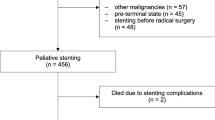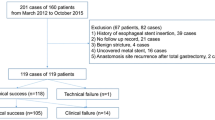Abstract
The use of metal stents for malignant esophageal strictures for palliation is well accepted. However, utilization of metal stents for benign esophageal diseases has been controversial. Given the availability of removable, fully covered, self-expandable metal stents (RFCSEMSs), this study was undertaken to evaluate the effectiveness and safety of RFCSEMSs in patients with refractory benign esophagogastric anastomotic strictures. Twenty-four patients with RFCSEMSs were enrolled in this study. All patients had undergone endoscopic Savary-Gilliard bougie dilatation five times or more but there was no significant improvement in symptoms. For all 24 patients, the symptom of dysphagia was alleviated significantly while the stent was in place and for a short time after stent removal, and dysphagia scores decreased from 3–4 to 0–1. After 12 months of follow-up, 18 patients were free from dysphagia but the other 6 patients still suffered obvious dysphagia. RFCSEMSs are still not perfect and can induce some complications. The treatment failure rate of restenting was remarkably high after the first failure. Given that effective methods for treating refractory stricture have not been found, RFCSEMSs could be considered for treating refractory benign esophagogastric anastomotic stricture.


Similar content being viewed by others
References
Pierie JP, de Graaf PW, Poen H, van der Tweel I, Obertop H. Incidence and management of benign anastomotic stricture after cervical oesophagogastrectomy. Br J Surg. 1993;80:471–4.
Lew RJ, Kochman ML. A review of endoscopic methods of esophageal dilation. J Clin Gastroenterol. 2002;35:117–26.
Honkoop P, Siersema PD, Tilanus HW, Stassen LP, Hop WC, van Blankenstein M. Benign anastomotic strictures after transhiatal esophagectomy and cervical esophagostomy: risk factors and management. J Thorac Cardiovasc Surg. 1996;11:1141–8.
Said A, Brust DJ, Gaumnitz EA, Reichelderfer M. Predictors of early recurrence of benign esophageal strictures. Am J Gastroenterol. 2003;98:1252–6.
Ikeya T, Ohwada S, Ogawa T, Tanahashi Y, Takeyoshi I, Koyama T, Morishita Y. Endoscopic balloon dilation for benign esophageal anastomotic stricture: factors influencing its effectiveness. Hepatogastroenterology. 1999;46:959–66.
Spechler SJ. AGA technical review on treatment of patients with dysphagia caused by benign disorders of the distal esophagus. Gastroenterology. 1999;117:233–54.
Scolapio JS, Pasha TM, Gostout CJ, Mahoney DW, Zinsmeister AR, Ott BJ, Lindor KD. A randomised prospective study comparing rigid to balloon dilators for benign esophageal strictures and rings. Gastrointest Endosc. 1999;50:13–7.
Pereira-Lima JC, Ramires RP, Zamin I Jr, Cassal AP, Marroni CA, Mattos AA. Endoscopic dilation of benign esophageal strictures: report on 1043 procedures. Am J Gastroenterol. 1999;94:149–501.
van Heijl M, Gooszen JA, Fockens P, Busch OR, van Lanschot JJ, van Berge Henegouwen MI. Risk factors for development of benign cervical strictures after esophagectomy. Ann Surg. 2010;251:1064–9.
McLoughlin MT, Byrne MF. Endoscopic stenting: where are we now and where can we go? World J Gastroenterol. 2008;14:3798–803.
Barthel JS, Kelley ST, Klapman JB. Management of persistent gastroesophageal anastomotic strictures with removable self-expandable polyester silicon-covered (Polyflex) stents: an alternative to serial dilation. Gastrointest Endosc. 2008;67:546–52.
Baron TH. Expandable metal stents for the treatment of cancerous obstruction of the gastrointestinal tract. N Engl J Med. 2001;344:1681–7.
Madhusudhan C, Saluja SS, Pal S, Ahuja V, Saran P, Dash NR, Sahni P, Chattopadhyay TK. Palliative stenting for relief of dysphagia in patients with inoperable esophageal cancer: impact on quality of life. Dis Esophagus. 2009;22:331–6.
Sandha GS, Marcon NE. Expandable metal stents for benign esophageal obstruction. Gastrointest Endosc Clin N Am. 1999;9:437–46.
Bethge N, Sommer A, Gross U, von Kleist D, Vakil N. Human tissue responses to metal stents implanted in vivo for the palliation of malignant stenoses. Gastrointest Endosc. 1996;43:596–602.
Kochman ML, McClave SA, Boyce HW. The refractory and the recurrent esophageal stricture: a definition. Gastrointest Endosc. 2005;62:474–5.
Eloubeidi MA, Lopes TL. Novel removable internally fully covered self-expanding metal esophageal stent: feasibility, technique of removal, and tissue response in humans. Am J Gastroenterol. 2009;104:1374–81.
Eloubeidi MA, Talreja JP, Lopes TL, Al-Awabdy BS, Shami VM, Kahaleh M. Success and complications associated with placement of fully covered removable self-expandable metal stents for benign esophageal diseases (with videos). Gastrointest Endosc. 2011;73:673–81.
Laasch HU, Marriott A, Wilbraham L, Tunnah S, England RE, Martin DF. Effectiveness of open versus antireflux stents for palliation of distal esophageal carcinoma and prevention of symptomatic gastroesophageal reflux. Radiology. 2002;225:359–65.
Acknowledgments
We thank all the patients who participated in this research.
Author information
Authors and Affiliations
Corresponding author
Additional information
J. Liu and Y. Hu contributed equally to this study.
Rights and permissions
About this article
Cite this article
Liu, J., Hu, Y., Cui, C. et al. Removable, Fully Covered, Self-expandable Metal Stents for the Treatment of Refractory Benign Esophagogastric Anastomotic Strictures. Dysphagia 27, 260–264 (2012). https://doi.org/10.1007/s00455-011-9361-1
Received:
Accepted:
Published:
Issue Date:
DOI: https://doi.org/10.1007/s00455-011-9361-1




